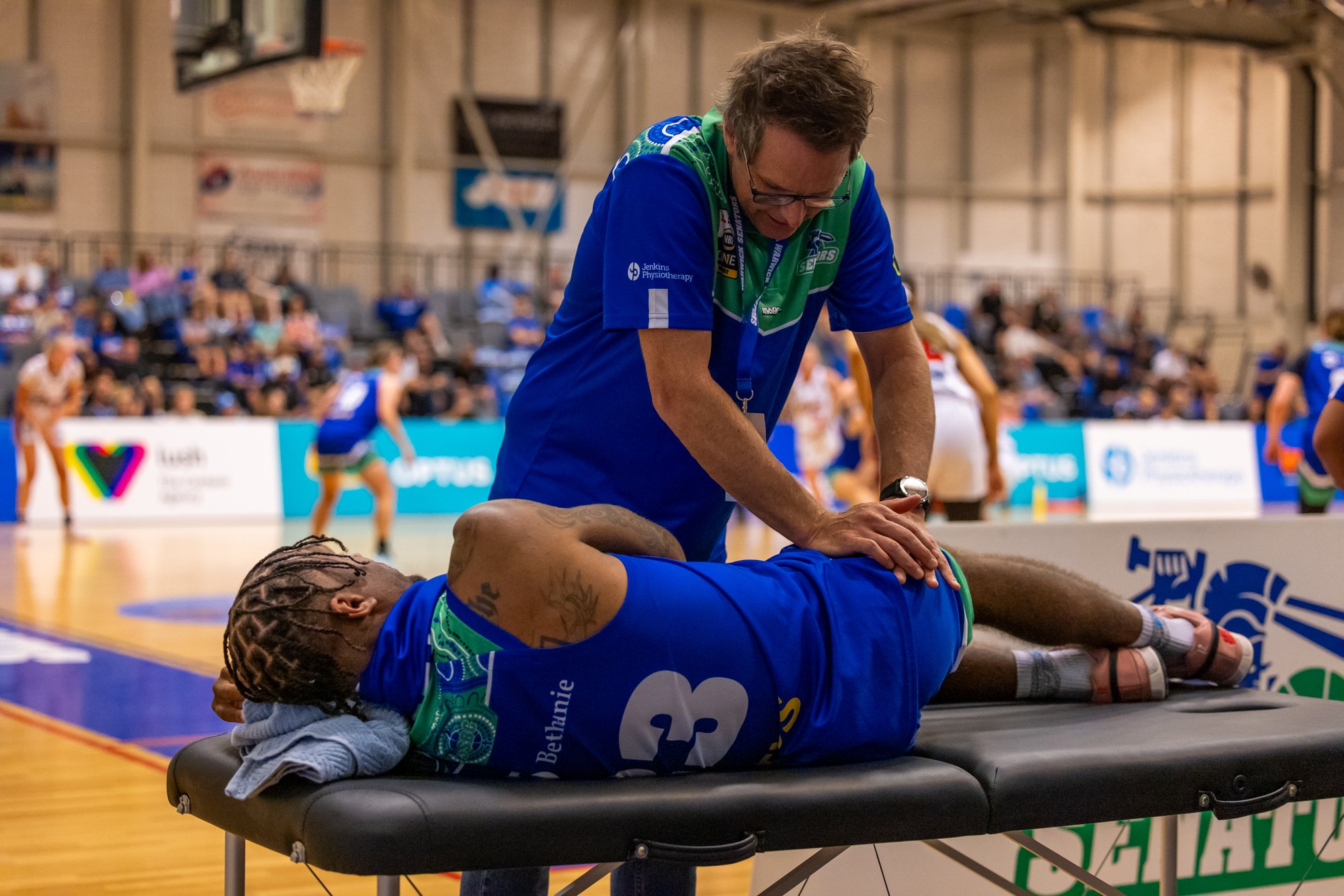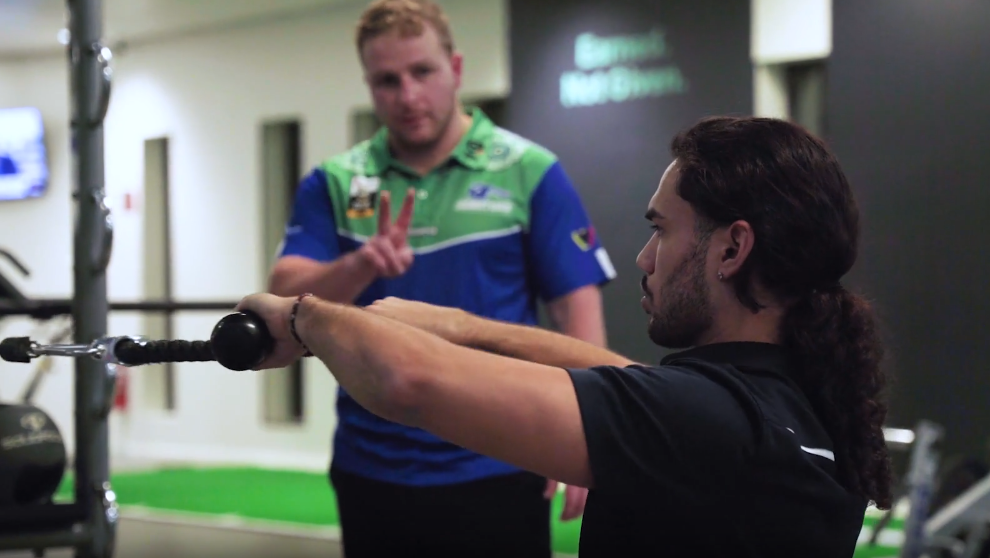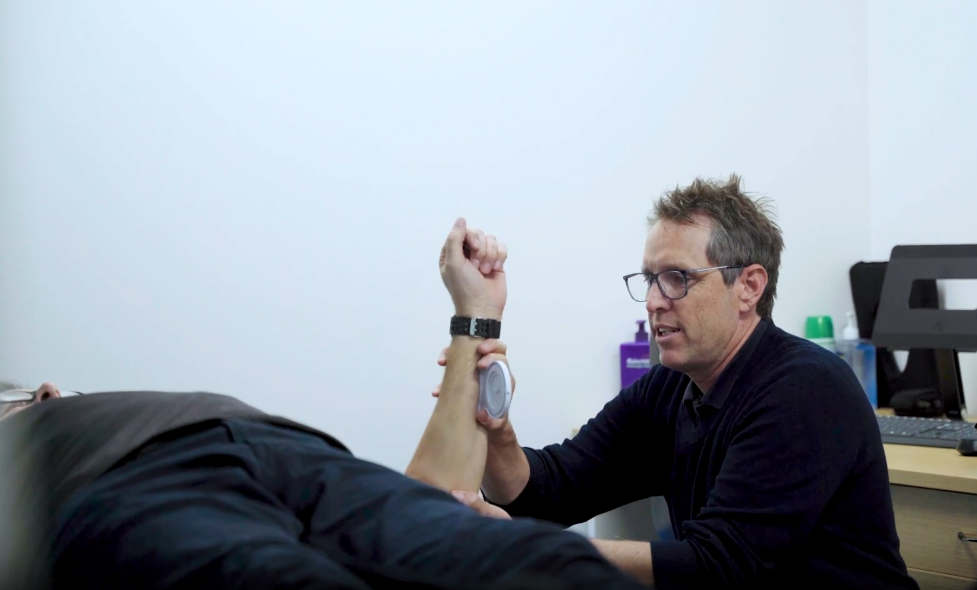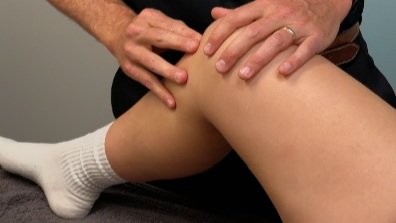
Your fast track to recovery starts here at Jenkins Physiotherapy!
At Jenkins Physio, you will receive the best of hands on treatment, exercise and pain science, but we can’t do it without you.
Ultimately we need an effective collaboration and engagement to coach/guide you along your pain or injury journey and back to your life and goals.
We work with you to discover the myriad of factors relevant to your story and presentation and what it all means to you based on how your current problem is stopping you achieving what you want to be doing

Fast Track recovery at Jenkins Physiotherapy!
Read along for our 5 step process for systemised success:
Reflect -thorough assessment, review scans, screening questionnaires, consider other factors
Relieve - Individualised care & education, Hands on treatment, Dry Needling, Exercise advice
Restore - Exercises and Active recovery for all, resume work or sport ASAP
Review - Track, modify or refer at 2, 6 or 12 week intervals, and between sessions
Results - Non-surgical care for most, Fast Track Recovery at Jenkins Physiotherapy
Step 1: Reflect
✅ 𝗧𝗵𝗼𝗿𝗼𝘂𝗴𝗵 Subjective and Objective Assessments ✅ Review scans ✅ Screening questionnaires ✅ Consider other factors
What is a t𝗵𝗼𝗿𝗼𝘂𝗴𝗵 Physiotherapy a𝘀𝘀𝗲𝘀𝘀𝗺𝗲𝗻𝘁? A guided conversation to gain a thorough detailed history to highlight reflections on 'YOUR STORY', your problem, symptoms, general health and a physical/functional assessment to screen for significant injury or pathology. We look to gain a considered overview and working diagnosis, excluding serious pathology and psychosocial factors eg cancer, fracture, neurological conditions or infection, discover unhelpful beliefs and expectations shaped by previous personal experiences or those of others that may be prolonging symptoms.
For example: What's the plan with a thorough shoulder pain assessment? To get the best result, we want to find out is your shoulder stuck/stiff, hypermobile (instability), are the muscles out of sync (motor control) or is it deconditioned (use it or lose it)?
The Jenkins Physiotherapy Subjective assessment
Looks to tie together three things, where we have a chat and learn your story through a series of questions to determine:
timeline of symptoms
a clear mechanism of injury
a story that fits
- Was there was an incident, or has it just built up over time?
- Is the pain constant or coming and going?
- What factors might be at play like recent life changes, stress, low mood or anxiety issues -
- What have been your previous treatments and proposed diagnoses, and what has helped sofar
- Are there red flags - unremitting pain, can't sleep, feeling unwell etc, or yellow flags?

The Jenkins Physiotherapy Objective assessment
This process looks to take measures to support a working diagnosis informed by our chat, and your story.
Active Range of Movement - noting quality as well as range of neck, shoulder and back
Strength Testing of rotator cuff and accessory muscles
Functional movement eg press and pull type activities
Looking for aggravating and easing positions and adjustments
Putting together the subjective AND objective findings helps lead us to a working diagnosis and potential others. For example Rotator Cuff Related Shoulder Pain (RCRSP) is the umbrella term for rotator cuff tendinopathy and subacromial impingement. Other common diagnoses are overuse, frozen shoulder, and AC joint injury. Note that it may take a learning period to discover the approach to which your shoulder responds to best.
A postural assessment is where we observe your neck position (chin in or out?), shoulder position (is one lower or higher than the other?), mid back curve (is it naturally a long kyphosis or very straight?), scoliosis (is one side of your spine higher than the other and where?), are you listing (leaning - usually away from the sore side).
Review Scans Together
Treat the (wo)man NOT the scan! Having completed a thorough shoulder assessment (for example), we would hope to have a working diagnosis to work with for a couple of weeks. There can often be overlapping symptoms and behaviours that can influence the story, accuracy of special tests, and clinical decision making, which just adds to the complexities that we sort through together! Rest assured, if there is no significant change after 2-6 weeks, and you've followed all the advice to manage the ups and downs, then you may be recommended to get a scan to make sure nothing else has been missed.
Research, scans and clinical practice all have to complement your individual situation and must be understood as a whole. MRIs have been shown to increase anxiety and alarm if not interpreted carefully. Where it gets tricky is that there are age related norms, and often similar changes on both shoulders despite one being painful and the other not at all. So yes scans can be informative, but sometimes aren't always helpful. If results have plateaued after a few weeks of trying exercises and hands on treatment it's something to considerbeing mindful of the mantra ‘treat the (wo)man, not the scan’
Screening Questionaires
To gain a better understanding of your shoulder pain, sometimes we need to take a deep dive and use screening tools. Some are quite specific to the shoulder while others can be quite general. They are basically there to help you reflect on your pain experience in meaningful ways that can help inform our approach to maximise your recovery.
For example, a general questionairre is the Short Form Orebro which helps breakdown elements including pain, anxiety, fear avoidance and expectations. A couple of shoulder specific examples include the Shoulder Pain and Disability Index, and the Disability of the Arm, Shoulder and Hand. These aren't always necessary, but can be quite handy (pardon the pun!) at the right times.
But wait, there’s more!
There are four common factors that can contribute to longer recovery times and are called YELLOW flags which are important to consider in evaulating your prognosis.
🟨 𝗟𝗼𝘄 𝗺𝗼𝗼𝗱, anxiety, inability to stop worrying, and catastrophising language eg 'my knee is trash', 'I'm stuck like this forever', and a common comment ‘bone on bone’
🟨 𝗠𝗮𝗹𝗱𝗮𝗽𝘁𝗮𝘁𝗶𝗼𝗻𝘀 to life activity and personal beliefs for fear of making it worse - the emotional response to an experience that is perceived as threatening, eg limping which causes stress elsewhere, or overactive lumbar muscles which actually compress the spine…it’s not your fault, but your CNS does it sub consciously!
🟨 𝗙𝗲𝗮𝗿 𝘁𝗼 𝗺𝗼𝘃𝗲 and feeling vulnerable for fear of further pain and reinjury (Kinesiophobia) is actually the biggest predictor for ongoing symptoms, even more so than pain intensity or scan findings.
🟨 𝗥𝗲𝗰𝗼𝘃𝗲𝗿𝘆 𝗲𝘅𝗽𝗲𝗰𝘁𝗮𝘁𝗶𝗼𝗻𝘀 - based on past experiences and comparison with other peoples journeys, that is, we need an element of optimism and help you to find motivation to give things a go, and comfortable with some ups and downs on the recovery journey.
These can often be some of the hardest things to address, as we are often unaware of the personal biases and adaptations until we meet with a health professional ready to discuss these. Screening tools help us to get an accurate picutre of the other factors that play a role in a pain experience in addition to any physical injury.

Step 2: Relieve
✅ Individualised Care and Attention
At Jenkins Physiotherapy, understanding your problem, the cause of your pain, and your treatment options is critical to your recovery. We provide individualised education from the get go. Your advice is centred around your specific situation, goals, and self management strategies to help manage your pain and optimise recovery. We employ shared collaborative decision making, which means you get a say in what you think might help in your unique circumstances to Fast Track Your Recovery.
Treatment options may include hands on physiotherapy, which we call manual therapy, and includes things like joint mobilisation, soft tissue release, dry needling, and assisted stretching. Also helpful is guided advice on your situation, scans, past experiences, beliefs, and reassurance around likely healing times and how you can help. We consider recovery a collaborative team effort, and make every effort to find suitable interventions and great outcomes for you in your current situation, circumstannces and goals
A common question you will hear is ' What would you like to get out of today'? It might surprise you that not everyone says less pain...some say more understanding, more flexibility, a plan, or even just clarity. When you attend at Jenkins Physio, your session and care is all about and completely tailored to YOU!
Step 3: Restore
✅ Exercises and active recovery for all, get back on the court/ in the game / back to work asap
Exercise has been shown to be helpful in assisting recovery and should commence at the earliest opportunity. What type and how much exercise differs for each person, and also between stage of recovery eg early, mid, late stage healing, return to training (controlled), and competition (chaos)
'Hands on' treatments such as massage and manipulation may be helpful when used in conjunction with other modalities and management strategies, and should not be solely relied for the long term. Instead of just stand alone hands on treatment (including needles, and manipulation) don't be surprised that you will be expected to do your physio homework!
The best practice for musculoskeletal care may also include exercises for rehab and wellbeing, referral to psychology, information and education, and a ton of activity advice including dosage, progressions and regressions. Think of it as free physio each time you do your exercises! For example, the National Health Guidelines suggest that being a healthy human requires each week 150mins moderate aerobic exercise (or 75mins vigorous), and 2x strength sessions. While this is achievable for some, we will collaborate to set goals for you within your lifestyle to help you towards a great outcome, and fast track your recovery.

Step 4: Review
✅ Track, modify or refer at 2, 6 or 12 week intervals, and between sessions
We try to make progress as objective as possible so measuring and testing your response to treatment and exercise dosing is super important. We work with a great “village” of experts. We rely on eachother to help you as much as possible. This includes making use of your GP, along with Sports Doctors, Specialist surgeons, Podiatrists and other therapists with further skills to reach out to as necessary. The general tissue healing period is 12weeks, but depending on the type of tissue, age, general health, goals and past experiences, this number can vary. For example, a basic ankle sprain might feel 75% in 2-3 weeks, but collagen doesn’t ‘set’ for 6-8 weeks, so your ankle still needs further care and attention. Another example is the meniscus in the knee, generally takes 6-8 weeks to ‘forgive’ the twist or similar, however if we aren’t seeing improvements in 3-4 weeks, you may be referred for a scan if we feel collaboratively, that it will help you fast track recovery. One last example is tendon material eg shoulder, achilles, elbow. The tendons (which connect muscle to bone) are relatively avascular (not much blood flow), so they don’t heal themselves without the right loading patterns. Research suggests improvements may be seen at 4-6 weeks, but may not be evident for three months depending on any number of individual factors.
Acute (new) injuries tend to be reviewed twice weekly for a couple weeks to gauge response to treatment and exercises. Treatments often then reduce to once weekly, fortnightly or monthly depending on severity, irritability and the nature of your sprain, pain or niggle.
Step 5: Results
✅ Non-surgical care for most
According to best scientific evidence, the majority of cases do not require surgical intervention. With the right decisions early enough, some patience and collaborative joint decisions, non-surgical care should be trialled for at least three months. We encourage you to engage with your body to get the greatest outcomes. Active involvement in your recovery enables your body to respond consciously and subconsciously to assist with tissue healing, reduction of pain responses and engage more fully in the activities you find rewarding and enjoyable.
Our services:
Our Physios have all of the latest equipment available for treatments at our Madeley Physiotherapy and Warwick Stadium Physiotherapy clinics to be able to best help you fastrack recovery from injury and to keep active!
This includes:
Sports Physiotherapy
Pelvic and continence Womens Health and Mens Health - Annissa
Vestibular Physiotherapy - BPPV, vertigo - Rochelle
Sports\Basketball screening - Tim
Muscle strength testing (hand held dyno)
Fully equipped Pilates studio PLUS gym based rehab equipment
Pain, joint, muscle, nerve and bone injury management
Spine manipulation (not neck) and mobilisation treatments
Pre and post operative rehabilitation
Clinical exercise, Pilates classes
Sports Taping
Dry Needling
Remedial Massage Therapy - Kate and Mila
Injury prevention
Strength and conditioning
Workers Compensation claims

How does hands on Physiotherapy work?
Desensitise bodily areas that are painful
Feel better by the activation of opioids, oxytocin and dopaminergic pathways (our bodies natural pain relief systems)
Communicate empathy and kindness
Help your central nervous system discriminate between safe and threatening sensations
Hands on touch is important and super helpful but, we do keep in mind that current research suggests that hands on physiotherapy treatment probably isn’t:
deactivating trigger points
breaking down adhesions
lengthening tissue
activating muscles
substantialy increasing blood flow to the tissue
We will also advocate for your health and a healthy lifestyle… pain and structural patholgy aren’t always correlated. They are two different systems which we take into account based on your individual profile. Your scan is not your destiny!
Experiencing pain is often the reason people reach out to physiotherapy, these are some of the things we discuss that can contribute to your pain or injury:
how are your sleep habits?
are you exercising regularly?
are you eating nutritious foods?
do you have a good balance between workload and rest? - recovery is important!
are you aware of the effect of stress on a biological system, internal (psychological) and external (physical)?
Get clarity with an accurate diagnosis and likely prognosis based on compliance and collaboration. We will prescribe or modify movement, exercise and physical activity and set you up for self management and success. We will experiment with movement to see what suits you best and helps get you moving and recovering sooner. Most of all our aim is that you have a positive experience and achieve your desired outcomes and goals.
Common Conditions we see:
Jenkins Physio for lower back pain, Back strains, strengthening, stretches, disc bulge/protrusion, facet irritation, sacroiliac joint pain, piriformis syndrome, sciatica, scoliosis, poor posture etc
Jenkins Vestibular Physio for BPPV and dizzyness - Rochelle
Jenkins Physio for Neck Pain, wry neck, headaches, pinched nerve, poor posture
Jenkins Physio for Shoulder pain, tendinopathy, impingement, arthritis, rotator cuff tears, SLAP lesion, post op rehab, AC joint sprain
Knee cap (patella) tracking issues, jumpers knee, bursitis, knee arthritis, meniscus tears, Osgood Schlatters disease, post op rehab for replacements and ACL reconstructions etc
Ankle sprains, tendinopathy, achilles, bursitis, impingement
Womens Health, Clinical Pilates, Osteoporosis, Mens Health
Gym rehab, knee rehab, Pointe shoe fitting
Tennis elbow, golfers elbow, biceps tendinopathy, nerve entrapment
Wrist carpal tunnel syndrome, de Querivans tenosynovitis, tendinopathy, arthritis, post op rehab
Hip bursitis, impingement, hip flexor strain, tendinopathy, arthritis, post op rehab for replacements and arthroscopies etc
Foot pain: flat feet, turf toe, fractures, lis franc injury, plantar fasciitis, Sever’s disease
Muscle strains: thigh - quadriceps and hamstrings, gluteals, groin, hip flexor, calf (gastroc).
Cardio: COPD and the Active Cycle of Breathing technique
Other: We often see all kinds of variations and overlaps of symptoms. We offer professional injury management.

